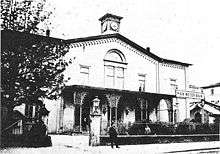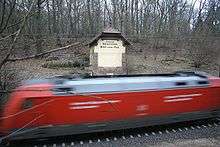Main–Weser Railway
| Main-Weser Railway | |
|---|---|
| Overview | |
| Native name | Main-Weser-Bahn |
| Type |
Heavy rail, Passenger/freight rail Intercity rail, Regional rail, Commuter rail |
| Status | Operational |
| Locale | Hesse |
| Termini |
Kassel Hbf Frankfurt Hbf |
| Stations | 52 |
| Line number | 3900 |
| Operation | |
| Opened | Stages between 1848 - 1852 |
| Owner | Deutsche Bahn |
| Operator(s) | DB Bahn |
| Technical | |
| Line length | 199.8 km (124.1 mi) |
| Track gauge | 1,435 mm (4 ft 8 1⁄2 in) standard gauge |
| Electrification | 15 kV/16.7 Hz AC Overhead line |
| Operating speed |
160 km/h (99.4 mph) Southern part only |
| Route number |
614.9 (RegioTram to Treysa) 620 (Kassel–Gießen) 630 (Gießen–Frankfurt) 645.6 (S-Bahn to Friedberg) |
| Main–Weser Railway | |||||||||||||||||||||||||||||||||||||||||||||||||||||||||||||||||||||||||||||||||||||||||||||||||||||||||||||||||||||||||||||||||||||||||||||||||||||||||||||||||||||||||||||||||||||||||||||||||||||||||||||||||||||||||||||||||||||||||||||||||||||||||||||||||||||||||||||||||||||||||||||||||||||||||||||||||||||||||||||||||||||||||||||||||||||||||||||||||||||||||||||||||||||||||||||||||||||||||||||||||||||||||||||||||||||||||||||||||||||||||||||||||||||||||||||||||||||||||||||||||||||||||||||||||||||||||||||||||||||||||||||||||||||||||||||||||||||||||||||||||||||||||||||||||||||||||||||||||||||||||||||||||||||||||||||||||||||||||||||||||||||||||||||||||||||||||||||||||||||||||||||||||||||||||||||||||||||||||||||||||||||||||||||||||||||||||||||||||||||||||||||||||||||||||||||||||||||||||||||||||||||||||||||||||||||||||||||||||||||||||||||||||||||||||||||||||||||||||||||||||||||||||||||||||||||||||||||||||||||||||||||||||||||||||||||||||||||||||||||||||||||||||||||||||||||||||||||||||||||||
|---|---|---|---|---|---|---|---|---|---|---|---|---|---|---|---|---|---|---|---|---|---|---|---|---|---|---|---|---|---|---|---|---|---|---|---|---|---|---|---|---|---|---|---|---|---|---|---|---|---|---|---|---|---|---|---|---|---|---|---|---|---|---|---|---|---|---|---|---|---|---|---|---|---|---|---|---|---|---|---|---|---|---|---|---|---|---|---|---|---|---|---|---|---|---|---|---|---|---|---|---|---|---|---|---|---|---|---|---|---|---|---|---|---|---|---|---|---|---|---|---|---|---|---|---|---|---|---|---|---|---|---|---|---|---|---|---|---|---|---|---|---|---|---|---|---|---|---|---|---|---|---|---|---|---|---|---|---|---|---|---|---|---|---|---|---|---|---|---|---|---|---|---|---|---|---|---|---|---|---|---|---|---|---|---|---|---|---|---|---|---|---|---|---|---|---|---|---|---|---|---|---|---|---|---|---|---|---|---|---|---|---|---|---|---|---|---|---|---|---|---|---|---|---|---|---|---|---|---|---|---|---|---|---|---|---|---|---|---|---|---|---|---|---|---|---|---|---|---|---|---|---|---|---|---|---|---|---|---|---|---|---|---|---|---|---|---|---|---|---|---|---|---|---|---|---|---|---|---|---|---|---|---|---|---|---|---|---|---|---|---|---|---|---|---|---|---|---|---|---|---|---|---|---|---|---|---|---|---|---|---|---|---|---|---|---|---|---|---|---|---|---|---|---|---|---|---|---|---|---|---|---|---|---|---|---|---|---|---|---|---|---|---|---|---|---|---|---|---|---|---|---|---|---|---|---|---|---|---|---|---|---|---|---|---|---|---|---|---|---|---|---|---|---|---|---|---|---|---|---|---|---|---|---|---|---|---|---|---|---|---|---|---|---|---|---|---|---|---|---|---|---|---|---|---|---|---|---|---|---|---|---|---|---|---|---|---|---|---|---|---|---|---|---|---|---|---|---|---|---|---|---|---|---|---|---|---|---|---|---|---|---|---|---|---|---|---|---|---|---|---|---|---|---|---|---|---|---|---|---|---|---|---|---|---|---|---|---|---|---|---|---|---|---|---|---|---|---|---|---|---|---|---|---|---|---|---|---|---|---|---|---|---|---|---|---|---|---|---|---|---|---|---|---|---|---|---|---|---|---|---|---|---|---|---|---|---|---|---|---|---|---|---|---|---|---|---|---|---|---|---|---|---|---|---|---|---|---|---|---|---|---|---|---|---|---|---|---|---|---|---|---|---|---|---|---|---|---|---|---|---|---|---|---|---|---|---|---|---|---|---|---|---|---|---|---|---|---|---|---|---|---|---|---|---|---|---|---|---|---|---|---|---|---|---|---|---|---|---|---|---|---|---|---|---|---|---|---|---|---|---|---|---|---|---|---|---|---|---|---|---|---|---|---|---|---|---|---|---|---|---|---|---|---|---|---|---|---|---|---|---|---|---|---|---|---|---|---|---|---|---|---|---|---|---|---|---|---|---|---|---|---|---|---|---|---|---|---|---|---|---|---|---|---|---|---|---|---|---|---|---|---|---|---|---|---|---|---|---|---|---|---|---|---|---|---|---|---|---|---|---|---|---|---|---|---|---|---|---|---|---|---|---|---|---|---|---|---|---|---|---|---|---|---|---|---|---|---|---|---|---|---|---|---|---|---|---|---|---|---|---|---|---|---|---|---|---|---|---|---|---|---|---|---|---|---|---|---|---|---|---|---|---|---|---|---|---|---|---|---|---|---|---|---|---|---|---|---|---|---|---|---|---|---|---|---|---|---|---|---|---|---|---|---|---|---|---|---|---|---|---|---|---|---|---|---|---|---|---|---|---|---|---|---|---|---|---|---|---|---|---|---|---|---|---|---|---|---|---|---|---|---|---|---|---|---|---|---|---|---|---|---|---|---|---|---|---|---|---|---|---|---|---|---|---|---|---|---|---|---|---|---|---|---|---|---|---|---|---|---|---|---|---|---|---|---|---|---|---|---|---|---|---|---|---|---|---|---|---|---|---|---|---|---|---|---|---|---|---|---|---|---|---|---|---|---|---|---|---|---|---|---|---|---|---|---|---|---|---|---|---|---|---|---|---|---|---|---|---|---|---|---|---|---|---|---|---|---|---|---|---|---|---|---|---|---|---|---|---|---|---|---|---|---|---|---|---|---|---|---|---|---|---|---|---|---|---|---|---|---|---|---|---|---|---|---|---|---|---|---|---|---|---|---|---|---|---|---|---|---|---|---|---|---|---|---|---|---|---|---|
Legend | |||||||||||||||||||||||||||||||||||||||||||||||||||||||||||||||||||||||||||||||||||||||||||||||||||||||||||||||||||||||||||||||||||||||||||||||||||||||||||||||||||||||||||||||||||||||||||||||||||||||||||||||||||||||||||||||||||||||||||||||||||||||||||||||||||||||||||||||||||||||||||||||||||||||||||||||||||||||||||||||||||||||||||||||||||||||||||||||||||||||||||||||||||||||||||||||||||||||||||||||||||||||||||||||||||||||||||||||||||||||||||||||||||||||||||||||||||||||||||||||||||||||||||||||||||||||||||||||||||||||||||||||||||||||||||||||||||||||||||||||||||||||||||||||||||||||||||||||||||||||||||||||||||||||||||||||||||||||||||||||||||||||||||||||||||||||||||||||||||||||||||||||||||||||||||||||||||||||||||||||||||||||||||||||||||||||||||||||||||||||||||||||||||||||||||||||||||||||||||||||||||||||||||||||||||||||||||||||||||||||||||||||||||||||||||||||||||||||||||||||||||||||||||||||||||||||||||||||||||||||||||||||||||||||||||||||||||||||||||||||||||||||||||||||||||||||||||||||||||||||
| |||||||||||||||||||||||||||||||||||||||||||||||||||||||||||||||||||||||||||||||||||||||||||||||||||||||||||||||||||||||||||||||||||||||||||||||||||||||||||||||||||||||||||||||||||||||||||||||||||||||||||||||||||||||||||||||||||||||||||||||||||||||||||||||||||||||||||||||||||||||||||||||||||||||||||||||||||||||||||||||||||||||||||||||||||||||||||||||||||||||||||||||||||||||||||||||||||||||||||||||||||||||||||||||||||||||||||||||||||||||||||||||||||||||||||||||||||||||||||||||||||||||||||||||||||||||||||||||||||||||||||||||||||||||||||||||||||||||||||||||||||||||||||||||||||||||||||||||||||||||||||||||||||||||||||||||||||||||||||||||||||||||||||||||||||||||||||||||||||||||||||||||||||||||||||||||||||||||||||||||||||||||||||||||||||||||||||||||||||||||||||||||||||||||||||||||||||||||||||||||||||||||||||||||||||||||||||||||||||||||||||||||||||||||||||||||||||||||||||||||||||||||||||||||||||||||||||||||||||||||||||||||||||||||||||||||||||||||||||||||||||||||||||||||||||||||||||||||||||||||
The Main–Weser Railway (German: Main-Weser-Bahn) is the railway line in central Germany that runs from Frankfurt am Main via Gießen to Kassel and named after the railway company that built the line and also operated it until 1880. It was opened between 1849 and 1852 and was one of the first railways in Germany.
Route
Based on today’s kilometre markers the line is 199.8 km (124.1 mi) long between its termini. It is double-tracked and electrified. Its maximum speed limit is 160 km/h (99.4 mph), but this is only achievable in places on the southern part of the line. The Main–Weser Railway is one of the most important conventionally operated German railways.
History

The idea of building the Main–Weser Railway began in 1838 as a link between Kassel and the Rhine-Main area running exclusively through the territory of Hesse-Kassel (Kurhessen) and connecting the major cities of the electorate from Kassel to Hanau via Fulda. At that time it proved impracticable to build such a line (the route of the Frederick William Northern Railway and the Frankfurt–Bebra railway) because of its mountainous route, particularly at the watershed between the Fulda and Kinzig valleys at Distelrasen, where a tunnel was only completed in 1914.
So instead from 1841 negotiations commenced with some other states and was interrupted several times. On 5 April 1845, a treaty was signed between the Free City of Frankfurt, the Grand Duchy of Hesse-Darmstadt and the Electorate of Hesse-Kassel, establishing a joint state railway company, known as a condominium railway (Kondominalbahn). This established the legal basis for the line via Marburg, Gießen and Friedberg through easier terrain to the originally preferred route, but which crossed national boundaries several times. In the southern sector the route ran after its exit from the Main-Weser station in Frankfurt approximately parallel with the street of Taunusstraße (at that time, only partly built), along the current streets of Friedrich-Ebert-Anlage and Hamburger Allee to the then Kurhessen town of Bockenheim, now the site of Frankfurt (Main) West station. It then ran again through the territory of Frankfurt in Hausen, through Kurhessen in Eschersheim, and through Frankfurt territory in Bonames. The line then went through the Grand Duchy of Hesse town of Boden bis Friedberg, then a piece of Frankfurt-owned territory in Dortelweil. Bad Nauheim was a Kurhessen enclave within the Grand Duchy of Hesse exclave of Oberhessen through which the line ran to Gießen. Under the treaty, each of the participating governments were responsible for the purchase of land on their territory. Financing the construction of the line proved to be more difficult. Construction occurred during the turmoil of the revolutions of 1848 and a financial crisis in the Grand Duchy of Hesse.
Work began on 6 August 1846 in Kurhessen territory. Here the Belgian engineer Frans Splingard and his colleague Edward Hacault were in charge. In Frankfurt construction was directed by Remigius Eyssen. The building of station on almost all sections of the line in Kurhessen was directed by Julius Eugen Ruhl, the first Director General of the Kurhessen railways. The first section between Kassel and Wabern was opened on 29 December 1849. The first continuous rail service from Kassel to Frankfurt ran on 15 May 1852, after the opening of the line between Gießen and Langgöns, connecting the northern and the southern sections of the line.
The second track was added in 1865—following twelve years of negotiations. The cooperation of the participating countries had not improved despite rapidly developing rail services. The second track significantly eased the transport of Prussian troops in the War of 1866, a war which led to the annexation by Prussia of two of the states involved in Main–Weser Railway, Hesse-Kassel and the Free City of Frankfurt. Their shares were subsequently transferred to Prussia. In 1880, Prussia also acquired the Grand Duchy of Hesse’s shares in the company.
Until the completion of the Frankfurt–Bebra line in 1866, all express trains between Frankfurt and Berlin ran on the Main–Weser Railway. These trains ran on to the Frederick William Northern Railway at Guntershausen to connect with the Thuringian Railway. Express trains continued to run from Frankfurt to Berlin via Kassel until the end of World War II. In the following years of the American occupation trains also ran on this route. In 1878/79 the Treysa–Lollar section of the line was incorporated into the strategic railway known as the Kanonenbahn (English: Cannons Railway) built between Berlin and Metz.
During the 1960s, the first section of the line was electrified between Frankfurt and Giessen; electrification of the line was completed on 20 March 1967.
Operations
Two long distance routes run on the Main–Weser Railway. These are the cross-country routes of Intercity line 26 running at two-hour intervals between Karlsruhe or Konstanz and Stralsund or Hamburg-Altona. From December 2009 to December 2011 a pair of Euro City trains on line 62 ran from Siegen to Klagenfurt over the line between Giessen and Frankfurt, stopping at Bad Nauheim. Regional-Express train services operate between Frankfurt and Kassel and between Frankfurt and Siegen. The latter leave the line in Gießen, requiring a reversal. Regionalbahn trains operate between Marburg and Giessen and between Giessen and Friedberg. Line S6 of the Rhine-Main S-Bahn operates between Friedberg and Frankfurt South through the City Tunnel. The section between Treysa and Kassel is operated by RegioTram Kassel tram-trains as line RT 9. The RegioTram line commenced in May 2007 but initially only on weekends, it has since replaced the Regionalbahn trains on weekdays as well.
Many trains on the lines branching from Bad Vilbel, Friedberg, Giessen and Cölbe use some of the main line.
Many freight trains operate on the route including container trains and trains carrying farm equipment (such as tractors and combine harvesters) from factory. The line is also regularly used for military movements.
References
- Brake, Ludwig (2000). "Jahrbuch für Eisenbahngeschichte (Yearbook of Railway History)" (in German). 32: 5–16.
|chapter=ignored (help) - Eisenbahnatlas Deutschland (German railway atlas) (2007/2008 ed.). Schweers + Wall. 2007. ISBN 978-3-89494-136-9.
- Krause, Günter (2000). "Jahrbuch für Eisenbahngeschichte (Yearbook of Railway History)" (in German). 32: 17–27.
|chapter=ignored (help) - Landesamt für Denkmalpflege Hessen (State Conservation Hesse), ed. (2005). Eisenbahn in Hessen. Eisenbahnenbauten- und strecken 1839-1939 (Railways in Hesse. Rail construction and lines 1839-1939) (in German). 2.1,. Stuttgart: Theiss Verlag. pp. 142ff (Strecke 010). ISBN 3-8062-1917-6.
- Münzer, Lutz (2000). "Jahrbuch für Eisenbahngeschichte (Yearbook of Railway History)" (in German). 32: 28–60.
|chapter=ignored (help) - Münzer, Lutz. "Vom Kondominat zur Preußischen Staatseisenbahn—aus der Geschichte der Main-Weser-Bahn zwischen (From Condominium to Prussian State Railways—from the history of the Main-Weser Railway) 1866–1880". Zeitschrift des Vereins für Hessische Geschichte 107 (in German). pp. 291–314.
- Münzer, Lutz (2004). "Jahrbuch für Eisenbahngeschichte (Yearbook of Railway History)" (in German). 36: 91–104.
|chapter=ignored (help) - Sieburg, Dankwart (2000). "Jahrbuch für Eisenbahngeschichte (Yearbook of Railway History)" (in German). 32: 61–84.
|chapter=ignored (help) - Peter Schubert; von Uwe Lischewski, Bildteil (1995). Der Viadukt. Der Rosentalviadukt in Friedberg (The viaduct. The Rosental Viaduct in Friedberg) (in German). Friedberg: Bindernagelschen Buchhandlung. ISBN 3-87076-075-3.
External links
| Wikimedia Commons has media related to Main-Weser Railway. |
